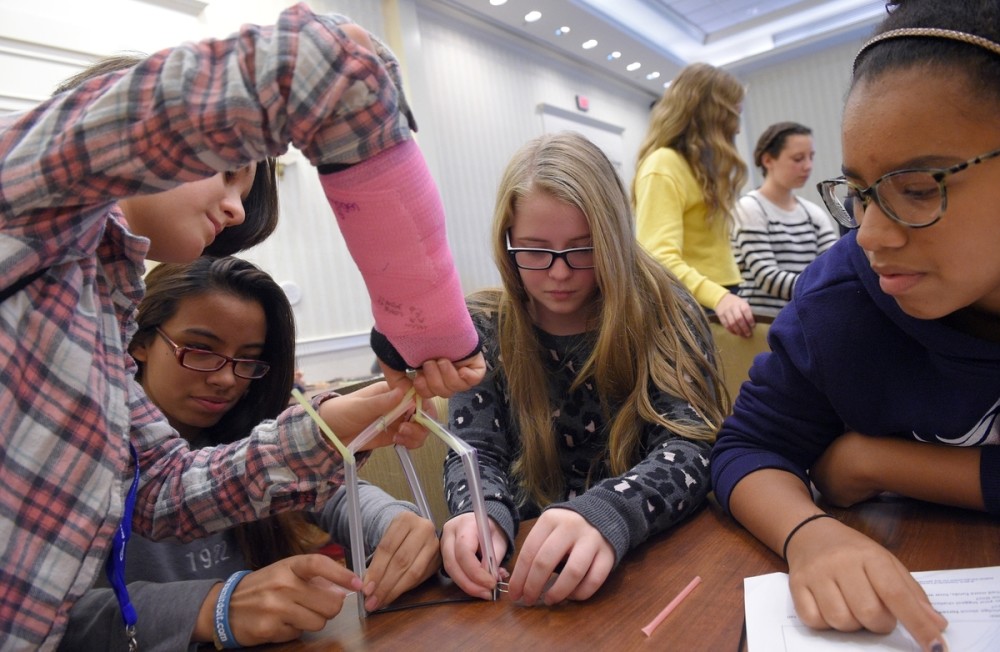By Julia Bergman
The Day, New London, Conn.
GROTON
Some of the students took no time to think about what they want to be when they’re older: a NASA engineer who helps to make rovers, a nuclear engineer.
Others were more general, saying they’d like to pursue a career in math, maybe as a teacher.
Then there were those who weren’t sure yet what they wanted to be, but whose interest was piqued through science or technology projects they’d done in school.
More than 150 girls from middle and high schools in Connecticut and Rhode Island attended an event held Friday at the Mystic Marriott aimed at getting them interested in manufacturing.
“How many of you think you want to make a lot of money when you go into business,” Lt. Gov. Nancy Wyman asked the students.
Most of them raised their hands.
Wyman then posed a slightly different question: “How many of you want to make as much money as a man makes in business?”
Hands shot up and several shouts of “more” were heard in the audience.
“Well you can make more too,” Wyman said.
The second-annual “Making it Real: Girls & Manufacturing Summit” put on by “Connecticut. Dream It. Do It.” and “Dream It. Do It. Rhode Island” sought to engage these young women through interactive and competitive workshops and female speakers in the science, technology, engineering and math field, better known as STEM.
“The truth is most places you go right now, you talk about certain fields, you will not make as much money as a man. You could be doing the exact same job,” Wyman said to the young women. “The one area that we’re finding that more and more women are getting … equal pay is under the STEM.”
Wyman spoke of her experience of running for and becoming the first women in Connecticut to be elected state comptroller.
Hailie Kesterson, 13, a student at West Side Middle School in Groton, got interested in astronomy after learning “a little bit” about it in sixth grade.
She’s been paying attention to NASA’s discoveries in Mars, most recently evidence of water on the planet. Now, she’s thinking she wants to be an engineer for NASA.
Kesterson said it doesn’t discourage her when she hears that STEM is a male-dominated field.
“It kind of makes me want to do it more just so I can stand out,” she said while she and a team of three other young women from West Side worked to fill pretend orders for ice cream sticks.
The workshop, where the young women formed teams that each acted as a company manufacturing custom, collectable ice cream sticks, was one of three the young women rotated through Friday.
They were given different orders detailing different designs and how much they’d get paid for filling each order.
Another workshop asked them to make the tallest skyscraper out of straws. They were given a budget of $5,000 and had to choose from a variety of different-sized straws, each costing a different amount, and paper clips.
Emilie Shutt, 13, one of teacher Michelle Mokrzewski’s students, enjoyed the skyscraper competition “because it definitely expanded our creativity.”
She enjoys building and crafts, “so this is right up my alley.” She’s made miniature furniture out of cardboard paper at home, she said.
Shutt thinks she might want to be a math professor one day.
The third workshop featured a K’Nex competition where the young women had to build a carnival ride out of K’nex, a construction toy system.
Each team acted as a company with logistics, assembly and customer service/quality control personnel and those in the “work cell” who actually built the ride.
Mokrzewski, STEM teacher at West Side, brought 18 of the girls currently taking her class to the summit. Mokrzewski said the students at West Side rotate through her STEM course so she teaches cohorts of students for 45 days at a time.
“I think our number one problem is kids don’t know about these careers so they can’t major in them. Then they can’t get jobs when they get out of school,” she said. “Our future is a lot of opportunities in the STEM fields. Why not expose them to that?”
During a question and answer session at the end of the summit, the students were able to ask women in STEM fields — an engineer from Electric Boat, the owner of a technology company, and others — about their professions.
Many of the girls asked, in varying ways, how women handle the male dominated field.
Willow Lyon, 13, another one of Mokrzewski’s students, isn’t sure if she wants to pursue a career in STEM when she’s older but she does find it interesting.
“It involves a lot of brain work and I kind of like that,” Lyon said.














































































































































































































































































































































































